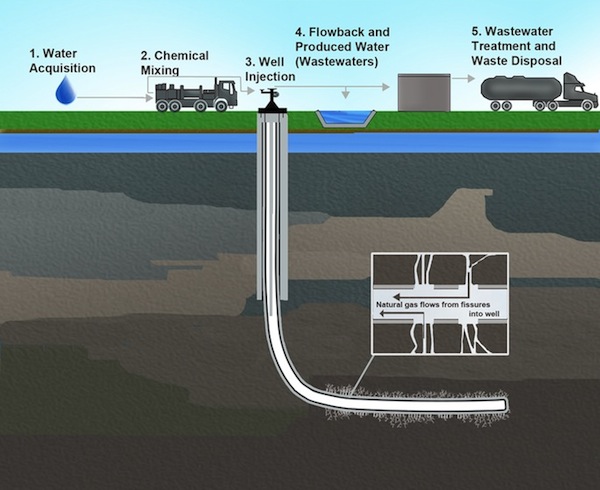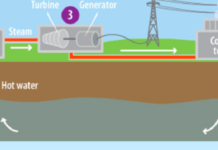On December 8, 2011, the Environmental Protection Agency (EPA) conducted a geological survey in a small Wyoming town to gauge the sanitation of the water supply. The data concluded that the aquifer of Pavillion, Wyoming was polluted. The community’s groundwater was tainted with traces of methane gas, lead, copper, and hydrocarbons. In the decade leading up to this study, the town of 174 residents witnessed the introduction of 200 natural gas wells. At the same time, the community became aware of the contamination in their water supply.
In an era of intense economic competition, prominent companies are constantly pursuing various methods to quickly and inexpensively obtain their necessary resources. For companies that market natural gas, the race for low-cost gas has resulted in the technique of hydraulic fraturing, or “fracking”. 
In an email correspondence, the American Natural Gas Alliance stated, “Natural gas is a clean, abundant and domestic energy source that supports more than 2.8 million jobs across our country. It is a true game-changer that we can put to use now for our nation's economy, environment and energy security”.
The U.S. Energy Information Administration, a governmental organization that observes data trends between energy, economy, and the environment, reports that around 30% of electricity in the United States comes from natural gas.
Duke University’s Nicholas School of The Environment states that within that figure, 30% was directly retrieved by fracking in 2010.
Fracking has become a widespread method in the recent years, as data from the American Petroleum Institute shows that 9 out of every 10 wells implements hydraulic fracturing. In that same vein, The National Petroleum Council projects that fracking will continue to be common. Their calculations suggest that 70% of new natural gas wells will require fracking in order to remain productive.
Jeanne Briskin, an EPA scientist, defines hydraulic fracking as “… a method to get natural gas or oil from petroleum bearing rocks or geology. First, you take water and mix in chemicals sand, and inject that underground at high pressure to fracture the rock that contains the mineral resource, the natural gas or oil. That creates surface area for the gas or oil to flow up to the surface.”
Energy from Shale, an alliance consisting of major gas companies, provides a more detailed description and states that after a well is drilled, the company pumps layers of cement to create a layer of protection for the groundwater (see figure). The drilling can go anywhere from 8,000 to 15,000 feet below the surface to avoid the aquifers that are about 300 feet beneath the ground. After this vertical drilling, horizontal drilling begins in order to pump fracking fluid into the well. At the same time, this pressure pierces the shale rock. When the process is completed, the equipment is removed and natural gas comes to the surface.
This practice is highly controversial. Environmental activists and scientists do not hesitate to protest fracking. Robert Jackson, a geochemist and director of Duke University’s Center of Global Change, found contamination in aquifers. His findings condemned fracking as a practice that threatens public health.
On the other hand, there are various business and researchers that advocate this extraction technique. “Despite the fact that hydraulic fracturing has been employed for half a century… opponents of natural gas insist that groundwater is now being contaminated. This claim…lacks substantive data to support its conclusions… [Furthermore] the industry has chosen to voluntarily disclose what additives are used at each well site via the FracFocus database,” shares Daniel Simmons, director of the nonprofit global energy systems organization, the Institute of Energy Research.
For those who oppose the practice, their argument begins with the materials used in fracking. The liquid that gas companies use to break the sub-surface rocks has caused a stir in the environmental community.
Earth Works Actions, an ecological non-profit organization, states that the fracking fluid itself is hazardous. This controversial substance contains over 600 different chemicals. Some of these are unsafe. Toxic chemicals such as methanol and benzene compose about 2% of fracking fluid. While this number may appear to be small, the toxins are amplified when millions of gallons are being poured into the earth. Furthermore, the liquid accumulates. Earth Works approximated that 20–85% of the tainted water continues to rest underground.
In 2012, Jackson and research scientists from Duke University and California State Polytechnic University described a correlation between the amount of methane gas in an aquifer and its proximity to a natural gas well in the research journal Proceedings of the National Academy of Sciences. Water supplies that were within one kilometer to a well had 17 times more methane on average than those further away. The group deduced that drilling made hazardous chemicals to seep through the protective concrete layer. The methane levels were so high that the scientists were able to set some samples on fire. Other samples also found hints of ethane, propane, and butane in areas that were next to drilling sites. The group also consulted local doctors. They found that residents of nearby homes had higher levels of health problems in juxtaposition to those who lived in the outer areas of the region. In early 2012, Dr. Richard Rinehart of Pennsylvania, a physician who oversees a local clinic, reported more cases of asthma, migraines, and skin afflictions after the drilling began.
Champions of hydraulic fracturing are quick to counter the allegations of pollution and health hazards. They point out the lack of facts in this study. Public Health experts have stated that a single community cannot reflect the overall effects of the process.
Christopher Portier, director of the National Center for Environmental Health and the Agency for Toxic Substances and Disease Registry said, “There's a lot of anecdotal evidence out there. And so a well-conducted study looking at a number of communities could help us better understand if there's an impact, what its magnitude [is], how we should avoid having that impact if there is one."
People within the natural gas industry also give the history of hydraulic fracturing. Fracking has been used since the 1947. In its 65 year history, trillions of cubic feet of natural gas have been produced. Fracturing has been approved by environmental advocates, such as Lisa Jackson, current head of the EPA. Jackson told US Senate that the practice did not appear to be especially hazardous to groundwater. The US Department of Energy and the Ground Water Protection Council also echo sentiments and do not denounce fracking.
Furthermore, new technology has made fracking more efficient. Natural gas companies are able to extract 12 times as much gas from a single well today than in previous decade. The Independent Petroleum Association of America shares that from 2005 to 2010, there was a 30% decrease in the amount of wells being drilled.
| Related stories: Growing Green Oil; Ready, Aim, Oil! |
According to the environmental group Earth Justice, natural gas is accessible and is found in areas such Arkansas, California, Colorado, Delaware, Louisiana, Maryland, and others. This practice is becoming more widespread as technology and opinions toward it evolve. Samantha Holmes

This work is licensed under a Creative Commons Attribution-NonCommercial-NoDerivs 3.0 Unported License














:good , This was very good because i didnt know hair dye can cause you to death and lose hair and face swelling. I use haird dye almost every 2 months and i havent noticed nothing different about me. But would have made it a little bit more interesting would be if they had pictures showing what would happen
Its good that you have this information
Pretty interesting
that cool to know:smile:good